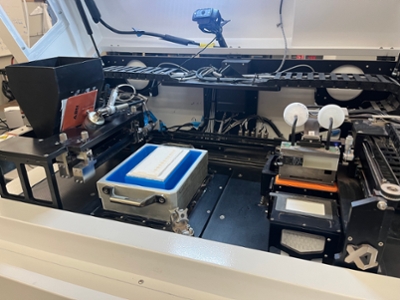
The Intergovernmental Panel on Climate Change reported in 2021 that “global warming will exceed 1.5 degrees Celsius and 2 degrees Celsius during this century unless deep reductions in carbon dioxide emissions occur.” Carbon capture is among the most effective approaches to reduce emissions. However, the high cost of existing carbon capture technologies is a barrier to their widespread adoption. Researchers at Texas A&M University are innovating ways to reduce the operation cost of carbon capture technologies.
Dr. Chao Ma, assistant professor in the Department of Engineering Technology and Industrial Distribution, and Dr. ZJ Pei, professor in the Wm Michael Barnes ’64 Department of Industrial and Systems Engineering, conduct research on ceramic 3D printing. They have found carbon capture to be an important application of ceramic 3D printing.
“Widespread adoption of carbon capture technologies can significantly reduce carbon emissions and eventually lead to net negative emissions in the future,” Ma said. “As a result, climate change could be alleviated, saving lives and economic losses from extreme weather events.”
Ma and Pei recently received a grant from the National Science Foundation’s (NSF) Partnerships for Innovation program. The latest grant allows them to apply the knowledge generated from their fundamental research started in 2018 with support from another NSF grant. Their previous study aimed to produce fundamental knowledge on 3D printing of ceramic materials using granulated powder. Ma said printing with granulated powder would result in interconnected pores, which is the key technology used to fabricate ceramic adsorbents for carbon capture in this new project.

“It is difficult and costly to produce ceramic components with hierarchical and interconnected pore structures using existing manufacturing methods such as conventional paste extrusion,” Pei said. “We will use 3D printing, probably the ideal manufacturing method to produce complex structures.”
3D printing is not commonly used for producing components to help address climate change.
“There is a lack of close collaboration between the two research communities — i.e., advanced manufacturing and industrial decarbonization,” Pei said. “It would be beneficial to bring together different experts to identify promising pathways for conducting convergent research.”
To have the most significant impact possible in all areas, Ma said one of the project’s goals is to form strong partnerships with industry, and the team is seeking industrial partners interested in carbon capture.
Along with the research, the project also serves as an educational and leadership development program to nurture future leaders in innovation and entrepreneurship. Students will participate in the NSF Innovation Corps (I-Corps) program to gain commercialization knowledge and insight into the commercial aspects of their inventions.
Graduate students will have the opportunities to play entrepreneurial and technical leadership roles in a future start-up company that will be established based on this project. They will also receive training on mentoring undergraduate students and present their research results to industrial partners, investors and customers. Undergraduate students will gain research skills and demonstrate a basic understanding of innovation and entrepreneurship.